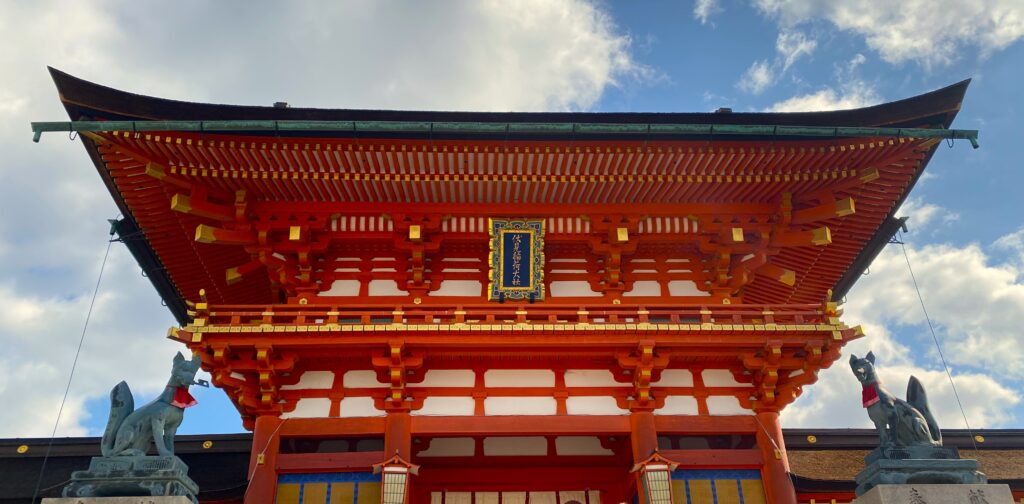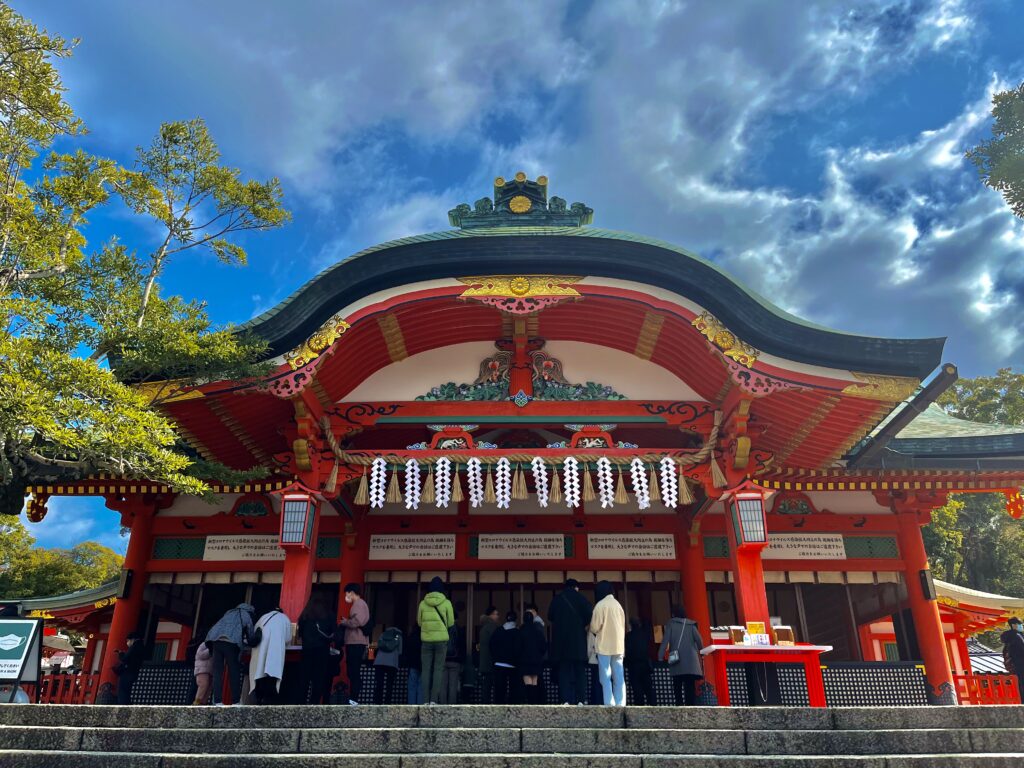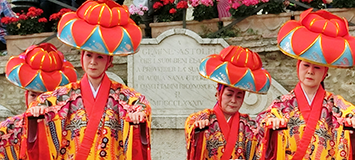SAMURAI BUILD 2F,
1-29 Katori-cho, Nakamura-ku,
Nagoya, Aichi Prefecture, Japan
FUSHIMI INARI SHRINE: A journey through tunnels of blazing vermillion gate throughout history and Japanese Pop Culture


Fushimi Inari Shrine (伏見稲荷大社 Fushimi Inari Taisha) is an important Shinto Shrine located in Southern Kyoto and it is one of the oldest and most important religious landmarks both in Kyoto and Japan. It enshrines Inari Deity, the Shinto God of foxes, rice, sake and business success. During the Edo Period, Inari was also considered the protector of blacksmiths and warriors.

Fushimi Inari is famous for its Senbon Torii thousands of vermillion torii gates which straddle a network of trails behind its main building through the wooded forest of Inariyama (the sacred Mount Inari). Each Torii gate has been donated by an individual or Companies in order to receive good luck in business. You will find the donator`s name and date of the donation inscribed on each gate. The cost of donating a Torii Gate starts at ¥400,000!
History
Fushimi Inari Shrine first structures were founded in 711 on by the Hata family, 80 years before Kyoto became the capital of Japan. In 816 they were relocated to its current spot at request of Monk Kukai. The main building, the Go-Honden with its colorful and elegant decorations dates back to 1499 and the Romon Gate was built in 1589 thanks to the Samurai warlord Toyotomi Hideyoshi`s donation. It is the largest one for shrines in Japan!
1871 Fushimi Inari Taisha was one of the most important government-sponsored Kanpei-taisha Shrines (as well as Kitano Tenmangu Shrine and Yasaka Shrine). This is because at the beginning of Meiji Restoration in 1868 till World War II emerged the “State Shinto” described as the ideological use by Imperial Japan of Shinto traditions in order to emphasise the central role of the priests and the emperor in both religious and political affairs.
Structure
Since Fushimi Inari Shrine covers a vast ground, it is better to divide its structure into two parts:
-At the bottom of the hill are located the two-stored Romon (the main tower gate), Ge-Haiden (a building used for Kagura dance performances during festivals) and Go-Honden (the main shrine) and
Romon Gate

Ge-Haiden

Okumiya
-Behind them, in the middle of the mountain, Okumiya (Inner Shrine) is reachable by a path lined with thousands of Torii. On its left, you can find the first of the series of giant torii gates leading through Senbon Torii.
Hiking to the top of Mount Inari: a hypnotic and pleasant path
If you like walking in the nature, then the hike to the summit of Mount Inari is a must! Mount Inari is 233 meter-high and it takes 2 hours to climb it. From the top you can enjoy an amazing panoramic view over Kyoto and it is a great 4 km-walking course surrounded by nature passing through tunnels of different torii gates.
Moreover, it is not so difficult as you can also take breaks during the trail, for example at “Fushimi Inari Santokutei”, a traditional teahouse where you can enjoy a pleasant view of Shin Ike Pond while resting and tasting delicious drinks and food.


If you don`t like crowds, you can experience Fushimi Inari`s spiritual atmosphere at night and enjoy the interplay of light and shadow thanks to a series of lights set on both sides of the torii gates.
The Kitsune (fox): the messengers of God Inari
The fox appears in the folklore of many cultures as a trickster animal. In Japanese folklore there are 13 different types of mythical kitsune, each corresponding a natural element but most commonly they are divided into evil foxes or benevolent foxes.
The first ones are wild and serve no God, they can even transform into humans, sometimes beautiful women in order to lure men. The second ones are the messengers of souls, such as the one that you see at Fushimi Inari Shrine and get wiser.



Once you arrive, you will see a lot of pair of Kitsune statues (usually male and female) representing the messengers of the Inari Deity. These foxes hold a symbolic item in their mouth or under their paw, such as a key representing the access to rice granary, a jewel or a scroll.
Moreover, according to the legend, the more tails a fox has, the wiser, older and more powerful it is meant to be.
Headpainted EMA
At Fushimi Inari Shrine you can write your wishes on a unique fox-shaped Ema wooden plaque.
Write on the back your wish, your address, your name, the date of Shrine visit and hung it in the dedicated area.
Then, why not granting a touch of unicity by drawing creative and funny faces?
Fushimi Inari Taisha inspired Souvenirs


Near Fushimi Inari is plenty of Souvenir Shops! Choose your favourite souvenir among t-shirts, fox masks (often worn with Yukata during summer festivals), socks, mini-torii gates, ceramic fox statues and more.
Hatsumode: New Year`s Hatsumode at Fushimi
Hatsumode is the Japanese custom of visiting a Shinto Shrine for the first time in the new year and Fushimi Inari Taisha is one of the most popular shrines for Hatsumode in Japan. Over 3 million of pilgrims flocked to the Shrine in 2017!
Many food stalls spring up near Fushimi Inari at New Year, selling traditional specialities such as Tsujiura Senbei, very similar to the american fortune cookies but made with miso and sesame or Aburaage (deep fried tofu) which is thought to be foxes’ favorite food or a matcha shaved ice.
Fushimi Inari in Japanese POP Culture
Do you know that “Fushimi Inari Taisha” appears in anime and films?
The plot of “Inari, Konkon, Koiiroha”, a supernatural romance anime, takes place here at Fushimi Inari.
Inari is the protagonist of the series and after saving a fox spirit, she was granted with the power to change her body shape at her will by saying the phrase “Inari, Konkon”.
“Konkon” refers to the sound that foxes were thought to made.
Fushimi Inari`s Senbon Torii appears in “Memoir of the Geisha” (2005) since the Shrine has been used as the filming location and it appears after 40 minutes and again on 136 minutes in a flashback scene.
The film was produced in the U.S.A but the director decided to bring the whole production team in Japan since it was impossible to replicate the beauty and age of historical temples and shrines.

Naruto has a lot of references to Japanese mythology and one of them is the representation of the Kitsune (fox).
Naruto is the protagonist of the plot.
A Nine-Tailed fox demon is sealed within his body and, whenever he access the chakra of the tailed beast, he becomes more powerful and stronger going berserk in several moments.
- category: Kyoto















